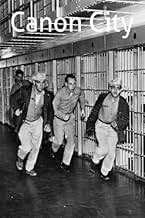Ajouter une intrigue dans votre langueTwelve inmates plan a prison break from the Colorado State Penitentiary but one of them reluctantly joins the group.Twelve inmates plan a prison break from the Colorado State Penitentiary but one of them reluctantly joins the group.Twelve inmates plan a prison break from the Colorado State Penitentiary but one of them reluctantly joins the group.
- Réalisation
- Scénario
- Casting principal
Reed Hadley
- Narrator
- (voix)
Histoire
Le saviez-vous
- AnecdotesFilm debut of Scott Brady.
- GaffesImmediately after the prison break, there's a shot of a crowd of people leaving a movie theatre, with Abbott & Costello in 36 heures à vivre (1948) (another Eagle-Lion release) prominently displayed on the readerboard. Only problem is, the break took place 30 December 1947, and The Noose Hangs High wasn't released until the end of the following April.
- ConnexionsReferenced in Let's Go to the Movies (1949)
Commentaire à la une
This movie proudly bears the label of a semi-documentary and comes complete with the usual Foreword about all the incidents being portrayed exactly as they happened, and all photographed on their actual locations, using real warders, guards and convicts, etc.
Personally, I doubt that the movie was shot in its entirety inside the actual prison there's even a credit for 2nd unit direction and photography. But be this as it may, the studio material is certainly extremely well integrated with the location footage. Credit for this achievement is mostly due to John Alton, whose masterful photography makes Canon City must watching for connoisseurs. True, Alton's work here is less tantalizing than usual as he was required to match up his shots with Strenge's rather dull location work. Nonetheless, there are still more than a few indications (the profile silhouette on Brady's face) of genius behind the camera.
Crane Wilbur's screenplay is less praiseworthy, but typical of that writer's detached, tabloid newspaper-style approach. He loves the sort of narrated rhetoric employed by contemporary newsreel commentators (Reed Hadley does a good job here with the actual narration), but fortunately his dialogue is less flowery and more realistic.
Generally Wilbur's direction rates as rather dull, but here his handling is even occasionally inventive, although his experiments are not always successful (as for example in the oddly oblique use of the first-person camera right at the beginning, with the on-screen characters swapping words with the disembodied narrator).
In all, however, the film emerges as a reasonably engrossing prison melodrama, convincingly acted (except oddly by the non-professionals), compellingly photographed, and tautly written. Despite its foregone conclusion, the storyline does build up a moderate amount of excitement and tension.
Personally, I doubt that the movie was shot in its entirety inside the actual prison there's even a credit for 2nd unit direction and photography. But be this as it may, the studio material is certainly extremely well integrated with the location footage. Credit for this achievement is mostly due to John Alton, whose masterful photography makes Canon City must watching for connoisseurs. True, Alton's work here is less tantalizing than usual as he was required to match up his shots with Strenge's rather dull location work. Nonetheless, there are still more than a few indications (the profile silhouette on Brady's face) of genius behind the camera.
Crane Wilbur's screenplay is less praiseworthy, but typical of that writer's detached, tabloid newspaper-style approach. He loves the sort of narrated rhetoric employed by contemporary newsreel commentators (Reed Hadley does a good job here with the actual narration), but fortunately his dialogue is less flowery and more realistic.
Generally Wilbur's direction rates as rather dull, but here his handling is even occasionally inventive, although his experiments are not always successful (as for example in the oddly oblique use of the first-person camera right at the beginning, with the on-screen characters swapping words with the disembodied narrator).
In all, however, the film emerges as a reasonably engrossing prison melodrama, convincingly acted (except oddly by the non-professionals), compellingly photographed, and tautly written. Despite its foregone conclusion, the storyline does build up a moderate amount of excitement and tension.
- JohnHowardReid
- 5 juil. 2008
- Permalien
Meilleurs choix
Connectez-vous pour évaluer et suivre la liste de favoris afin de recevoir des recommandations personnalisées
Détails
Box-office
- Budget
- 424 000 $US (estimé)
- Durée1 heure 22 minutes
- Couleur
- Rapport de forme
- 1.37 : 1
Contribuer à cette page
Suggérer une modification ou ajouter du contenu manquant

Lacune principale
By what name was Pénitencier du Colorado (1948) officially released in India in English?
Répondre

































